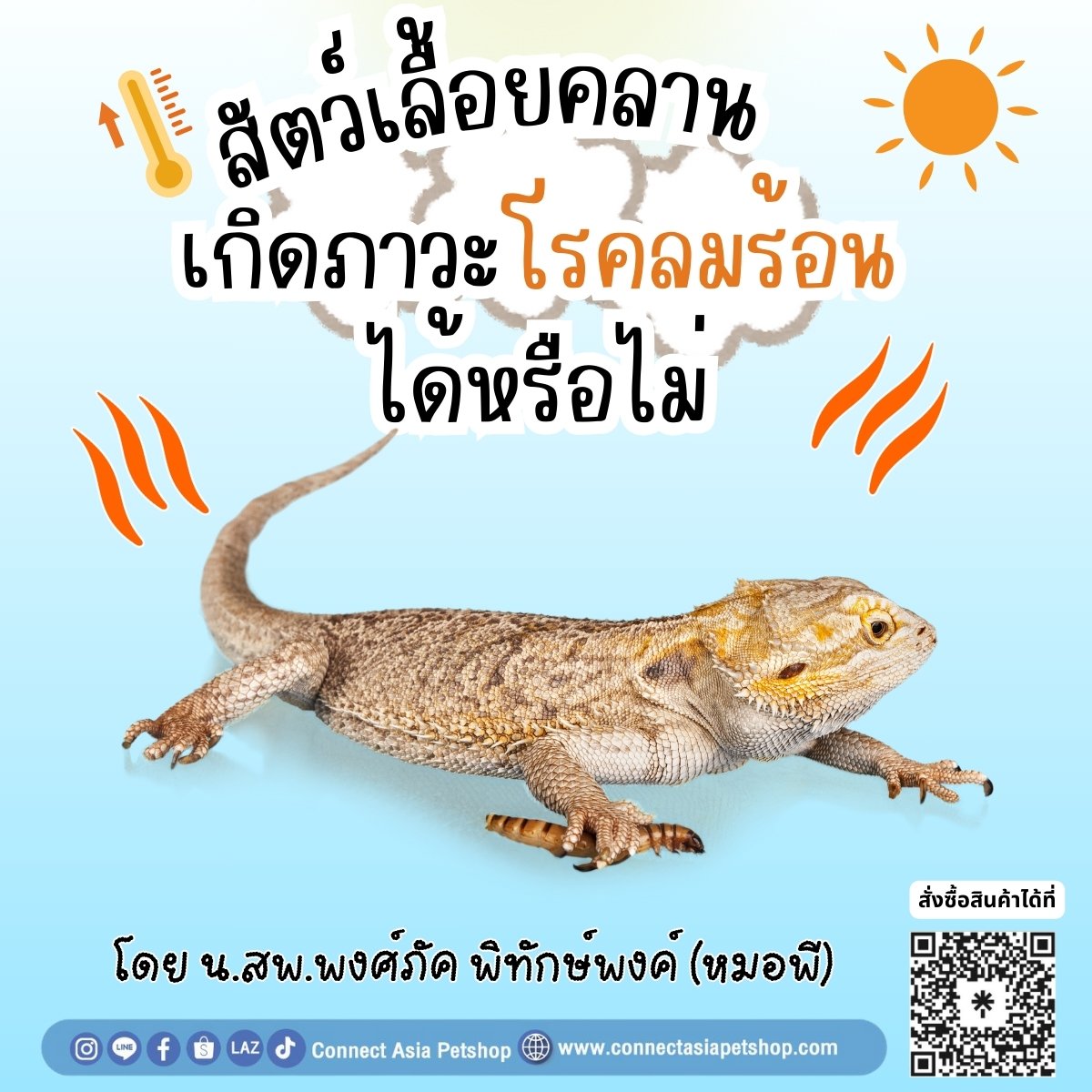Last updated: 13 Mar 2025 | 209 Views |

Can reptiles suffer from heatstroke? Heatstroke or Hyperthermia in Reptiles
By Dr. Phongsaphat Pitakphong (Dr. P), Khwankam Animal Hospital, Khon Kaen
.
Reptiles can suffer from heatstroke or heatstroke just like other animals, but the symptoms are harder to notice. Let's read on.
.
When reptiles that are raised cannot choose where to hide from the heat in a limited area, they are at risk of developing hyperthermia. When summer comes or even in other seasons when the animal's body is directly exposed to heat, it can also develop a condition called heatstroke. This is because the body creates or absorbs heat from the environment without being able to maintain heat balance (thermoregulation) by changing the set point of the hypothalamic temperature. Like mammals
In nature, reptiles will choose to hide when the temperature is very different from the preferred optimal temperature zone. Dangerous temperatures are higher than 36 degrees Celsius and lower than 4 degrees Celsius. Long-term exposure can cause death. They will hibernate in winter and summer or reduce their activities. For example, in very hot deserts, animals will hide in deep holes or choose to hide in forests connecting the desert and shrubs (subland), called aestivation. If the weather is very hot and dangerous, the hibernation period will be extended. They will then come out to find food when the weather is cooler. However, reptiles in cold regions will hibernate throughout the season (Hibernation).
.
When the environmental temperature is too high, reptiles receive more heat than they lose, causing their body temperature to be higher than necessary. The result is that animals have sudden dehydration. Blood pressure drops, which reduces blood perfusion to the brain, kidneys, liver, and other important organs, causing ischemia.
.
Factors related to excessive heat, in addition to insufficient space, are often related to open, unshaded habitats. Poor ventilation, lack of water sources, lack of holes, burrows or deep enough digging ground, obese animals cause poor heat dissipation, old animals, dense husbandry, transportation, stress or even anesthesia.
Natural habitats Animals living in the ocean are safer. Ecologically, the environment is less volatile, called a homogenous environment. Even the temperature itself has almost no effect on the deep sea. It is different from animals living on land, which is different, called heterogeneity. Animals will have behaviors, learn and adapt to natural changes by migrating, hiding and digging holes, etc. The inability to choose a place to live and improper management also put them at risk of heatstroke.
From the above factors, in addition to managing the area and raising them, in practice, breeders and veterinarians must monitor changes in temperature, measure temperature and humidity at all times. Water temperatures that are too hot for aquatic reptiles, assess the depth and width of the breeding pond. Excessive humidity causes poor ventilation, resulting in an increased risk of heatstroke, even sunbathing directly in the bright sun.
How do reptiles sense heat? Are they different from other animals?
One thing that veterinarians and animal scientists know is that reptiles have a poor ability to perceive heat from nerve endings compared to mammals. Therefore, skin burns are common and are often seen in snakes that get tangled in light bulbs. However, these animals can perceive heat well in other ways, such as infrared receptors in the pit organs, which are found in some species, and a very important organ, the pineal gland, which functions well in receiving both light and heat. Most reptiles use this physiological mechanism. Crocodiles have a dome-like organ on their head called dome pressure receptors, which are supplied by the trigeminal nerve, which helps them assess the surrounding temperature.
Most of the symptoms that can be observed include weakness, inability to perch, dehydration, reduced elimination, mouth opening, shortness of breath, tears, unconsciousness, or even seizures that can lead to death in cases of very high temperatures. Some cases have skin burns. In severe cases, internal organs become hot, inflamed, and lose their functions.
If we understand the concept of temporary hibernation, we will find that hot weather will reduce the body's metabolism, similar to winter hibernation in cold countries. Therefore, we often see a halt in movement. And if the temperature does not adjust to the appropriate range, the animal will die.
Are there any other mechanisms that reptiles try to protect themselves, besides the ones mentioned above?
Most self-defense is behavioral adaptation, but there is one mechanism that is not widely known, called heart rate hysteresis. Let me write it like this because it is difficult to explain by name, but I can explain it as a mechanism as follows. It is a mechanism that occurs as a result of the environment changing. The body will start to respond through two slow processes. Although the first process is said to occur almost immediately, it is slow and may take a long time. It was found that the heart rate will increase when the body temperature is high (which is possible even though the environment has been very hot for a long time) until the animal enters a state of reduced metabolism. On the contrary, the heart rate will decrease if the temperature is low. In mammals, this is also found. It was found that cold air can reduce the heart rate and reduce the need for oxygen.